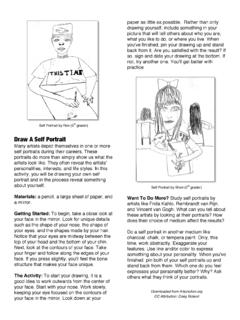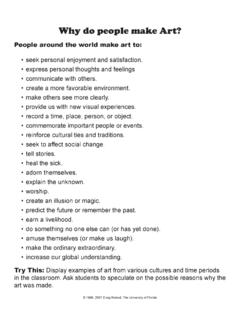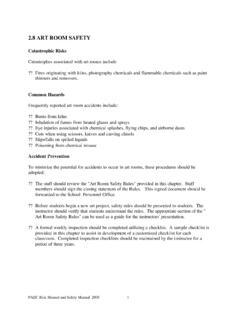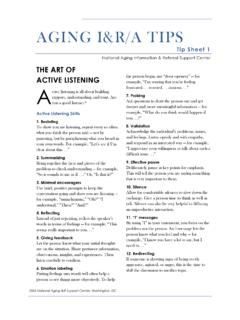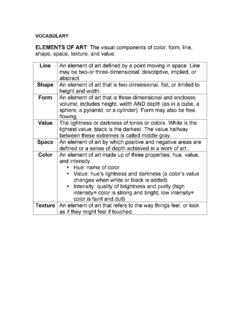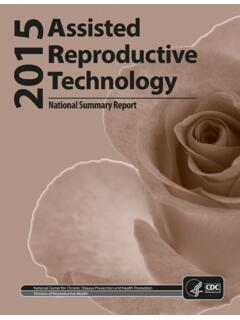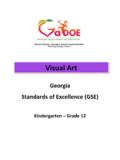Transcription of Young in Art - Art Junction
1 Young in Art a developmental look at child art Craig Roland 1990, 2006. Introduction As a result of the child study movement in the early 1900s, it is generally recognized that children progress through certain stages of development in their art making. Each stage may be identified by certain characteristics that show up repeatedly in their artwork. These stages have been linked to chronological age (particularly from 18 months to 6. years). However, a number of factors (both internal and external) affect a child's artistic , to expect that a particular child at a certain age should be at a certain stage of development is inappropriate. A number of theoretical models have been offered over the years to explain children 's artistic these models may vary ( , in the number of proposed stages), they all propose a similar pattern of development one of progressing from scrib- bling to realistic representation.
2 Other generalizations that may be made include: Socioeconomic factors seem to have little influence on the earliest stages. For example, all children begin drawing by scribbling. Moreover, girls and boys tend to draw alike at the early ages. children 's drawings typically show greater development than paintings because crayons, markers, and pencils are easier to control than paint and a brush. Considerable overlap exists between stages may be represented in one work and a child may regress to a previous stage before advancing to the next stage . It is unlikely that a child will reach the later stages without adult support or instruction. In other words, development in art is not universal and is dependent on the environment in which a child grows up and is educated. The following account suggests that there are four stages of children 's artistic develop- ment: scribbling, pre-symbolism, symbolism, and realism.
3 It is based on the popular view that the desired end state of this progression is graphical realism. However, this should not be taken to mean that the drawings that children typically do in earlier stages are inferior or less desirable to those accomplished in later stages. On the contrary, some of the more aesthetically pleasing works often are produced by children just beginning to discover the joys of mark making. 1. Art Begins with Scribbling All Young children take great pleasure in moving a crayon or pencil across a surface and leaving a mark. This form of mark making or scribbling represents children 's first self-initiated encounters with art. children typically begin scribbling around one-and-a- half years of age. Most observers of child art believe that children engage in scribbling not to draw a picture of something; rather they do so for the pure enjoyment of moving their arms and making marks on a surface.
4 Recently, however, a few researchers have challenged this traditional view by showing that Young children do occasionally experiment with representation even though their scribbles may not contain any recognizable new perspective suggests that children 's earliest mark-making activities may be more complex than previously thought. When children first start scribbling they usually don't realize they can make the marks do what they often scribble in a random fash- ion by swinging their arms back and forth across the drawing surface (fig. 1 & 2).The lines they make may actually go off the may even look away from the page as they work. But, it doesn't take long for children to recognize the relationship between their movements and the marks on the paper. As this discovery unfolds, children begin to control their scribbles by vary- ing their motions and by repeating certain lines Figure 1: Random scribble that give them particular pleasure.
5 Longitudinal Figure 2: Random Scribble marks in one or more directions may result. Circular patterns and geometric shapes begin to appear as children 's perceptual and motor abilities increase (fig. 3). Lines are combined with shapes to form various patterns and designs. Letter- forms, especially those in the child's name, may show up among the marks on the page (fig. 4). It is unfortunate that the very word "scribble" has negative connotations for adults. - Viktor Lowenfeld 2. The Teacher's and Parent's Role For most youngsters, scribbling is intrinsically reward- ing in itself, and thus no special motivation is needed. Perhaps the best contribution that the teacher or parent can make is to offer children the proper materials and the encouragement to engage in scribbling. In selecting appropriate art materials,it is important to provide scribblers with a medium that enables them to easily gain control of their such as crayons, non-toxic markers, ballpoint pens, and pencils work paints, on the other hand, are difficult for Young children to control and should be avoided.
6 Tempera paint can be used provided it is a fairly thick consistency so that it doesn't run down the page. Color does not play a particularly important role in colors offered should be few in number and provide good contrast with the paper used. A dark Figure 3: Controlled scribble crayon, marker, or pencil is recommended along with white or manila paper (12 by 18 inches).With tempera As children gain control of the marks on the page, paint, provide a large fairly absorbent sheet of paper they start to name their scribbles and engage in (18 by 24 inches) along with bristle brushes (one-half imaginative play when drawing. A child may an- inch in width). children can work on the floor or any nounce what he or she is going to draw before other horizontal surface when scribbling. beginning or may look at the marks on the page afterwards and say, This is mommy.
7 On another Talking With Scribblers day, the child may look at the same drawing and When talking with the beginning scribbler, simply com- say, This is my dog. To the adult, these drawings ment on the child's movements when scribbling. For may be neither recognizable nor remarkably dif- instance, notice how fast the child's arm is moving or ferent from early scribbles done by the , how big the child's movements are. As the child gains to the child making them, these seemingly control of scribbling, comment on the variety of move- unreadable marks now have meaning. ments and different marks the child has made. For instance, notice the number of circles the child has made or the nice lines going around the page.. As the child starts naming his or her scribbles, listen to the child's comments and use the meanings offered by the child as a source for dialogue.
8 For instance, if the child says, This is daddy, ask questions like Is your daddy tall? Does he pick you up? Where do you go with your daddy? If the child says, I'm running, ask ques- tions like Do you like to run on the playground? or Where are you running? Encouraging the child to ver- balize his or her thoughts, feelings and experiences independently shows the child that you value what he or she has sort of thoughtful praise will help children to be enthusiastic and imaginative in their future art encounters. Figure 4: Controlled scribble 3. Pre-Symbolism: The Figure Emerges Around three to four years of age, children begin to combine the circle with one or more lines in order to represent a human figures typically start out looking like tadpoles (fig. 5) or head- feet symbols (fig. 6). It is not uncommon for chil- dren's first representations of the figure to be highly unrealistic or to be missing a neck, body, arms, fingers, feet, or toes.
9 children may, in fact, draw two tadpole- like forms to show their mother and father without Figure 6: Head-feet symbols making visible distinctions between the two figures. Figure 5: A family portrait consisting of several tadpole figures Several theories have been proposed to explain the tadpole phenomenon and the reasons why Young children tend to draw unrealistic or incomplete human forms. Some experts suggest that children omit bodily features because of a lack of knowledge about the different parts of the human body and how they are organized. Others argue that children don't look at what they are drawing;. instead, they look at the abstract shapes already in their repertoire and discover that these forms can be combined in various ways to symbolize objects in the world. Still others believe that children are simply being selective and drawing only those parts necessary to make their figures recognizable as human forms.
10 It is important for teachers and parents to consider, from a diagnostic standpoint, that a child whom omits certain features when drawing a person may do so quite unintentionally; and, thus, caution should be exercised when interpreting a child's drawing as a reflection of personality or intellectual growth. 4. From an educational standpoint, teachers should also consider that experiences designed to extend children 's awareness of their own body parts often result in more compete representations of the figures they draw. For instance, children who depict figures without arms or hands might be given the opportunity to play catch with a ball and then to draw a picture of themselves playing catch. children will likely include arms and hands in their drawings since these parts are required to engage in this activity. Just asking children to draw such an experience is usually not need to become actively engaged in the activity being depicted in order to develop a personal awareness of the details involved.
